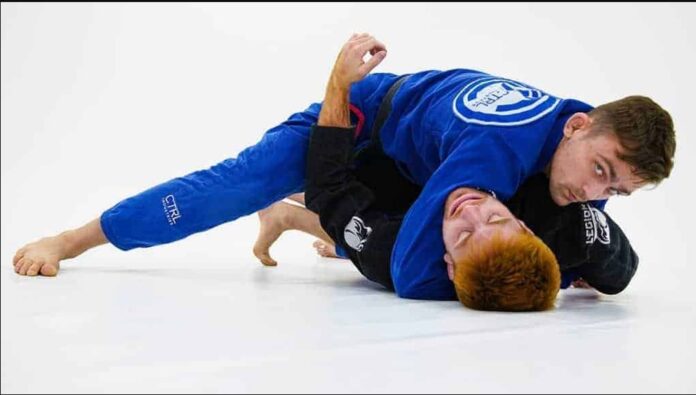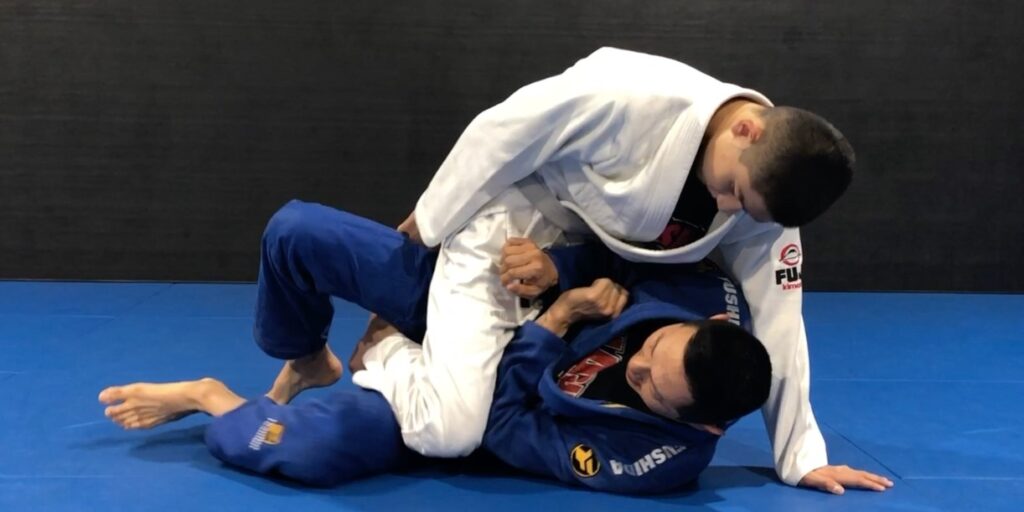
The “king” of Brazilian Jiu-Jitsu positions, the only real rival to staples like back control and Ashi Garami, the position that everyone instinctively wants to be in when fighting under any circumstances – the mount. One thing most people are not aware of, though is that there are many different variations of the full mount BJJ position. And yes, they do extend past just low mount, high mount, and S-mount. In fact, the ones I am about to present here today are much more fun (for you) and much more painful and nightmarish (for your opponents).
The Real Reason You Can’t Stay in The Full Mount BJJ Position For Long
Why can’t you keep a hold of people in the full mount BJJ position? The answer to this is easy – they can move. If they can move, they can create space, if they can create space they can replace the guard, get a reversal or perhaps turtle up. All of the above options are not what a person in mount control has as a goal. So, how do you stop it?
The biggest advantage of the mount position is that the person on the bottom has no way of retreating – there’s an entire planet behind them (regardless of your affiliation to either of the round or flat Earth claims). That takes care of one direction of escape. So., how come it is still difficult to prevent someone from snaking out? I used the term “snaking” here on purpose.
The only way somebody can effectively escape your mount is by wiggling forward or back in relation to you. In both situations, the person will need to either:
- Move you, and keep themselves still;
- Keep you in place, and move themselves;
- Move you and move themselves in a different direction.
If you take a closer look, you’ll notice that these types of movements cover every full mount BJJ escape you probably know so far: shrimping out (move themselves, keep you in place), bridge and roll (move both themselves and yourself), hip bump to butterfly (move you, while staying stationary themselves)… I could go on, but you get the point.
Bottom line is that as long as you understand how to control a snake it won’t be able to bite you. In terms of the mount in Jiu-Jitsu the same rules apply as if you’re trying to subdue a snake. You need to control the nake’s head, and the snake’s tail in order to keep it under control and stay safe.
In the mount, you are already past the legs, so the tail of the snake you need to focus on is the hips. Thea head of the opponent keeps the role of the head of the snake. That provides you with two points of control (hips and head) which will allow you to control someone from the top mount for very long periods of time.
While you could use the usual suspects (low, high, S-mount) to obtain control and pressure over your opponent, you could also opt for some more underrated and obscure-looking BJJ full mount variations.
Cruel And Unusual Full Mount BJJ Variations
The beauty about the full mount BJJ position is that you can adjust in a bunch of different ways and still be in the mount position. Keep in mind, though, that if you’re after points, some versions of the mount will not land you the expected 4 points even though you are practically in mount. The rules are dumb, I concur, but still, they are the rules… for now, at least. So, if you go into a mounted triangle for example, or if an opponent has both arms inside your legs, you won’t get any mount points. Just something to think about if you are a points chaser.
Apart from that, switching between different mount variations is how you should actually aim to play mount. Nothing happens in a vacuum in Brazilian Jiu-Jitsu, and there is no way to pin somebody to the ground and completely restrict them from moving. If you switch up the way your body is positioned in relation to theirs, though, even subtle shifts can completely disrupt an opponent’s escape attempts.
While we’re on the subject of switching up between different full mount BJJ variations, why not throw in a few curved balls while you’re doing it? Some of the positions I’ll explore below provide lots of pressure and will cause your opponents to panic. Others will make you feel light as a feather but will keep people stuck, or open up effortless entries into devastating submission holds.
Dope Mount
The Dope Mount can be a precursor to the full mount, but it could also be used to keep someone in place when they’re trying to escape and gaining ground doing so. It is basically mount that places your hips over one leg of the opponent (the top leg), while their bottom leg is essentially outside of the mount. So, you’re not riding their torso, but rather one of their legs, your hips at thigh level. This gives you control over the tail of the snake.
Controlling the head comes in the form of double underhooks, or at least one underhook (on the side opposite of the leg you’re riding) and a crossface. in any case, the goal is to have the opponent’s shoulder blades on the ground, while their hips are winded up to the side.
The position makes going into full mount easy, while also opening up interesting submission attacks and spinning/rolling transitions. It won’t get you points, but it will help you stay in mount.
https://www.youtube.com/watch?v=PumK7JZnOu0
Vegan Mount
One of my absolute favorite BJJ full mount variations. It is not just fun because you can get to the Honeyhole from it, but because it confuses opponent’s so much that they’ll stop wiggling and struggling on their way out and they’ll stay calm while attempting to figure out their next step. That is as easy as top control can get.
The Vegan mount concept is something I saw from Reilly Bodycomb. It is fairly simple, but you do have to remember that you need to keep your chest over the opponent’s head when doing this. Also, your arms should preferably touch the mats, over each shoulder, or hold a deep crossface. The concept is easy – put both of your feet on the inside of the opponent’s hips. Your knees should still aim to touch the ground.
While perhaps not that impressive at first sight, this BJJ full mount variation allows you to directly control the hips, aka the tail of the snake. Paired with head control of your choice, you can easily hold someone there. Moreover, you have the option of sneaking a leg in between the opponents, which can take you directly into the Inside Senkaku (aka Honeyhole) to hunt for heel hooks.
Why the name Vegan mount? As Bodycomb says: “It looks and tastes the same, but it is just not the real deal”
Wet Blanket Mount
One of the variations of the BJJ full mount I use on a regular basis. This one causes the most panic in the person on the bottom (in my experience) and is extremely easy to maintain. It is the perfect resting position for you that “happens” to provide you with an extreme amount of pressure that you can place onto your opponent.
The concept is easy – get to middle mount, place both of the opponent’s arms over their head, turn their head to break their posture, and relax. The last one here, relaxing is the most important aspect of this mount variation. You literally need to let your body go limp.
The analogy I use (learned it from Matt Thronton, I think) is that you are just like a wet blanket that has been placed on top of a person. The blanket is both heavy and it goes into every nook and cranny it can find aiming to reach the ground. DO the same with your body and you’ll be surprised at how easy it is to keep opponents still. Oh and expect them to emit a bunch of different groaning sounds as they suffer to come to terms with your pressure from top.
Technical Mount
A variation of mount that many shun because it seems like they are not in mount. It is a pity, given that the position not only offers great controlling and attacking options but it will also earn you the 4 points that you’re after.
The technical mount is a variation that has you with one knee and shin on the ground, and the other leg touching the mats with your foot. The opponent is usually turned on their side. All your weight is on top of the leg that has the shin on the ground, while your other leg is placed over the opponent, hamstring on top, and the calf across their stomach or chest.
The position is virtually halfway between mount and back mount, but it still constitutes a mount, which means you get 4 points if you can hold it for at least three seconds.s Holding the position becomes really easy if you are using the Gift Wrap grip, which will open up both mount and back mount control for you. The technical mount is the best spot to establish said grip.
A common reason why people skip over the technical mount as a control option is that they view things in black and white. It is either mount or back mount, anything in between is not as good. The technical mount is a great example of why this way of thinking is highly flawed.
Three-Quarter Mount
The three-quarter mount is technically not a mount, so no points for this full mount BJJ position. However, that doesn’t mean you should immediately dismiss it. The three-quarter mount is essentially a technical mount in which the top leg is still trapped between the opponent’s legs. That said, having a leg in there (a foot, to be more precise) is the main strength of this position rather than its weakness, as is often perceived.
The main idea here is that you can use the positioning of the “trapped” leg to gain easy back control (one hook is already in). Alternately, you can just stay in control of the snake’s tail via the “trapped” leg, while you establish a grip on their head. The Gift Wrap is once again a very efficient solution.
WHtehre you go to technical mount, full mount, or back control from there is down to you. Oh yeah, you can also choke people from the three-quarter mount. With lots of chokes.
Nightmare Mount
This has to be the worst possible scenario for the bottom person. I’ve gotten so many taps throughout the years from this mount variation, that I avoid using it often, as it feels like I am cheating. I found out the nuts and bolts of this full mount BJJ variation from Brandon McCaghren.
The “Nightmare” mount is a blend between an S-mount and the 10th Planet Jiu-Jitsu Spiderweb position. The goal is not to have an S-mount that lands you flat on your opponent’s chest. You want them to tilt so that your tailbone is actually pressuring their floating ribs. Ouch, I know!
In terms of S-mount positioning, just think about being at a 90-degree angle in relation to your opponent, while trapping both their arms in an S-mount configuration. The trick that will make you enormously heavy form there is to insert a deep hook with the arm that is near the opponent’s head. The goal is to thread it behind the crook of their elbow and try to connect that palm of that hand to the hip on the opposite side.
BU that is not all! If you want to make your opponent feel like they’re being crushed like a trash compactor, post with the ree arm on the mats, right next to their hips. Enjoy the pressure taps you’ll get from there!
Notable Mentions
There are a few other full mount BJJ variations that will help you keep people in place, regardless of how good their mount defense is. Here are three versions of the mount that should asl obe on your radar. Each of them deserves a separate article, so keep your eyes peeled if one of these options ends up being your favorite.
Monkey Mount. This is another 10th Planet Jiu-Jitsu position. It is a high mount variation in which one of your legs is deep under the armpit of an opponent (as if setting up a Monoplata). The other can be in a regular position by their body, or you could be stepping with your foot on the forearm of their opposite side arm. Needless to say, you can torture people from there in various fun ways.
Reverse Mount. Won’t’ get you points, but it will frustrate your opponents. As the name suggests, you’ll need to be sitting facing the legs rather than their head. While you could sneak your legs under their armpits, and hug their hips to get control of the snake, it is an lt more fun to just… sit on them. Hug both legs below their knees, and sit on your opponent. It will block their movement, frustrate them and you can do lots of fun stuff from there. Russian cowboy comes to mind first.
Turtle Mount. Once again, this full mount BJJ variation is as simple as the name suggests. You simply get t on top of your opponent and then ignore the fact that there’s a person underneath you. Simply go for the tightest turtle position you know, and you’ll end up with an air-tight mount that will keep even the most explosive 20-year-old wrestler in place.
In Summary
The full mount BJJ position is quite specific in terms of where you need to be in relation to the opponent, and in relation to the ground. Outside of those two aspects though, the position is still open for interpretation. Feel free to experiment with your own variation, or just go the easy route and try the 6 options I went over in this article. Happy hunting!


![Darce Choke Encyclopedia – Origins, Mechanics and Variations [2025] BJJ, choke, Brabo, BJJ Darce Choke, D'arce Choke, Darce BJJ Choke](https://bjj-world.com/wp-content/uploads/2017/11/JungPoirierLeeYahoo-218x150.jpg)














![Countering with Crab Ride Anthony Budion DVD Review [2025] Countering with Crab Ride Anthony Budion DVD Review](https://bjj-world.com/wp-content/uploads/2025/03/countering-with-crab-ride-anthony-budion-dvd-review-218x150.png)
![Closet Closed Guard Craig Jones DVD Review [2025] Closet Closed Guard Craig Jones DVD Review](https://bjj-world.com/wp-content/uploads/2025/03/closet-closed-guard-craig-jones-dvd-review-218x150.png)
![Xanadu Back Takes Levi Jones-Leary DVD Review [2025] Xanadu Back Takes Levi Jones-Leary DVD Review](https://bjj-world.com/wp-content/uploads/2025/03/xanadu-back-takes-levi-jones-leary-dvd-review-218x150.png)

![No-Gi Grapplers Guide To Front Headlock Joel Bane DVD Review [2025] No-Gi Grapplers Guide To Front Headlock Joel Bane DVD Review](https://bjj-world.com/wp-content/uploads/2025/03/no-gi-front-headlock-joel-bane-dvd-review-218x150.png)



![Miko Hytonen Lapel Chokes From Everywhere DVD Review [2024] Miko Hytonen Lapel Chokes From Everywhere DVD Review](https://bjj-world.com/wp-content/uploads/2024/10/miko-hytonen-lapel-chokes-from-everywhere-dvd-review-100x70.png)
![Best Marcelo Garcia Techniques by Team Marcelo Garcia DVD Review [2025] Best Marcelo Garcia Techniques by Team Marcelo Garcia DVD Review](https://bjj-world.com/wp-content/uploads/2025/02/best-marcelo-garcia-techniques-dvd-review-100x70.png)

![How to Double Leg Anyone Kevin Lee DVD Review [2024] How to Double Leg Anyone Kevin Lee DVD Review](https://bjj-world.com/wp-content/uploads/2024/11/how-to-double-leg-anyone-kevin-lee-dvd-review-100x70.png)


![Reverse De La Riva System Mikey Musumeci DVD Review [2024] Reverse De La Riva System Mikey Musumeci DVD Review](https://bjj-world.com/wp-content/uploads/2024/11/reverse-de-la-riva-system-mikey-musumeci-dvd-review-100x70.png)
![Daisy Fresh WHITE BELT Wrestling Curriculum DVD Review [2024] Daisy Fresh WHITE BELT Wrestling Curriculum DVD Review](https://bjj-world.com/wp-content/uploads/2024/10/daisy-fresh-white-belt-wrestling-curriculum-review-100x70.png)

![Trip Throw Dilemma Michael Pixley and Heath Pedigo DVD Review [2024] Trip Throw Dilemma Michael Pixley and Heath Pedigo DVD Review](https://bjj-world.com/wp-content/uploads/2024/10/trip-throw-dilemma-michael-pixley-dvd-review-100x70.png)
![Efficiently Executing X-Guard Giancarlo Bodoni DVD Review [2024] Efficiently Executing X-Guard Giancarlo Bodoni DVD Review](https://bjj-world.com/wp-content/uploads/2024/09/efficiently-executing-x-guard-giancarlo-bodoni-dvd-REVIEW-100x70.png)

![Baby Shark Guard System Diogo Reis DVD Review [2025] Baby Shark Guard System Diogo Reis DVD Review](https://bjj-world.com/wp-content/uploads/2025/02/baby-shark-guard-system-diogo-reis-dvd-review-100x70.png)

![EMU Guard 2.0 Benjamin Power DVD Review [2024] EMU Guard 2.0 Benjamin Power DVD Review](https://bjj-world.com/wp-content/uploads/2024/11/emu-guard-2-0-benjamin-power-dvd-review-100x70.png)
![Roger Gracie Closed Guard System DVD Review [2025] Roger Gracie Closed Guard System DVD Review](https://bjj-world.com/wp-content/uploads/2025/01/roger-gracie-closed-guard-system-dvd-review-100x70.png)
![Standing Leg Entries Alex West DVD Review [2025] Standing Leg Entries Alex West DVD Review](https://bjj-world.com/wp-content/uploads/2025/03/standing-leg-entries-alex-west-dvd-review-100x70.png)
![Jeff Glover DVD Bundle Review: Chokin’ Around With Uncle Jeff [2024] Jeff Glover DVD Bundle Review: Chokin' Around With Uncle Jeff](https://bjj-world.com/wp-content/uploads/2024/10/jeff-glover-dvd-bundle-review-chokin-around-100x70.png)


![Osoto Gari for Jiu Jitsu Jackson Nagai DVD Review [2024] Osoto Gari for Jiu Jitsu Jackson Nagai DVD Review](https://bjj-world.com/wp-content/uploads/2024/10/osoto-gari-for-jiu-jitsu-jackson-nagai-dvd-review-100x70.png)
![Understanding The Distance On Top Gui Mendes DVD Review [2024] Understanding The Distance On Top Gui Mendes DVD Review](https://bjj-world.com/wp-content/uploads/2024/10/distance-on-top-gui-mendes-dvd-review-100x70.png)
![Bricks Kesa Gatame System Jeremy Brick DVD Review [2025] Bricks Kesa Gatame System Jeremy Brick DVD Review](https://bjj-world.com/wp-content/uploads/2025/02/bricks-kesa-gatame-system-jeremy-brick-dvd-review-100x70.png)
![Dynamic Headquarters Passing Jason Rau DVD Review [2024] Dynamic Headquarters Passing Jason Rau DVD Review](https://bjj-world.com/wp-content/uploads/2024/10/dynamic-headquarters-passing-jason-rau-dvd-review-100x70.png)

![Crossing and Spinning Steps To Attack Israel Hernandez DVD Review [2024] Crossing and Spinning Steps To Attack Israel Hernandez DVD Review](https://bjj-world.com/wp-content/uploads/2024/09/spinning-steps-to-attack-israel-hernandez-dvd-review-100x70.png)

![The Whole Omoplata Enchilada Lyanne Perez DVD Review [2024] The Whole Omoplata Enchilada Lyanne Perez DVD Review](https://bjj-world.com/wp-content/uploads/2024/11/whole-omoplata-enchilada-lyanne-perez-dvd-review-100x70.png)